UAW Strike Means Supplier Layoffs

As United Auto Workers President Shawn Fain prepares to give an update on labor-contract negotiations this afternoon, the UAW’s three-week-old strike at plants across the Midwest is hurting auto suppliers, according to The Washington Post (subscription).
What’s going on: “More than 3,000 supplier employees have been affected so far, a Washington Post tally shows, while an industry association says nearly 30 percent of its supplier members have resorted to layoffs.”
- More than 60% of suppliers said they expected to begin layoffs this month. Others say these cuts could “broaden over time” if the strike continues
- The strike has reverberated beyond the automotive sector, too. U.S. Steel recently announced 300 temporary layoffs after it was forced to idle an Illinois furnace because of the walkouts.
Why it’s important: “The [strike’s] fallout shows the outsize role the auto industry plays in the U.S. economy, to which it contributes about 3 percent of gross domestic product.”
- What’s more, the widespread shuttering of smaller auto suppliers—which number in the thousands and are often the main source of employment in the areas where they operate—would make it harder for General Motors, Ford and Stellantis to resume normal operations after the strike.
Manufacturers say: “The longer the strike, the more likely thousands of citizens across Michigan will face layoffs, and not just UAW members,” John Walsh, president and CEO of the Michigan Manufacturers Association (an NAM state partner), wrote in The Detroit News (subscription).
- “Layoffs, in turn, will affect restaurants, stores and local businesses. The economic impact will be felt throughout our families and our communities.”
NAM, Rep. Stauber Talk R&D, Workforce
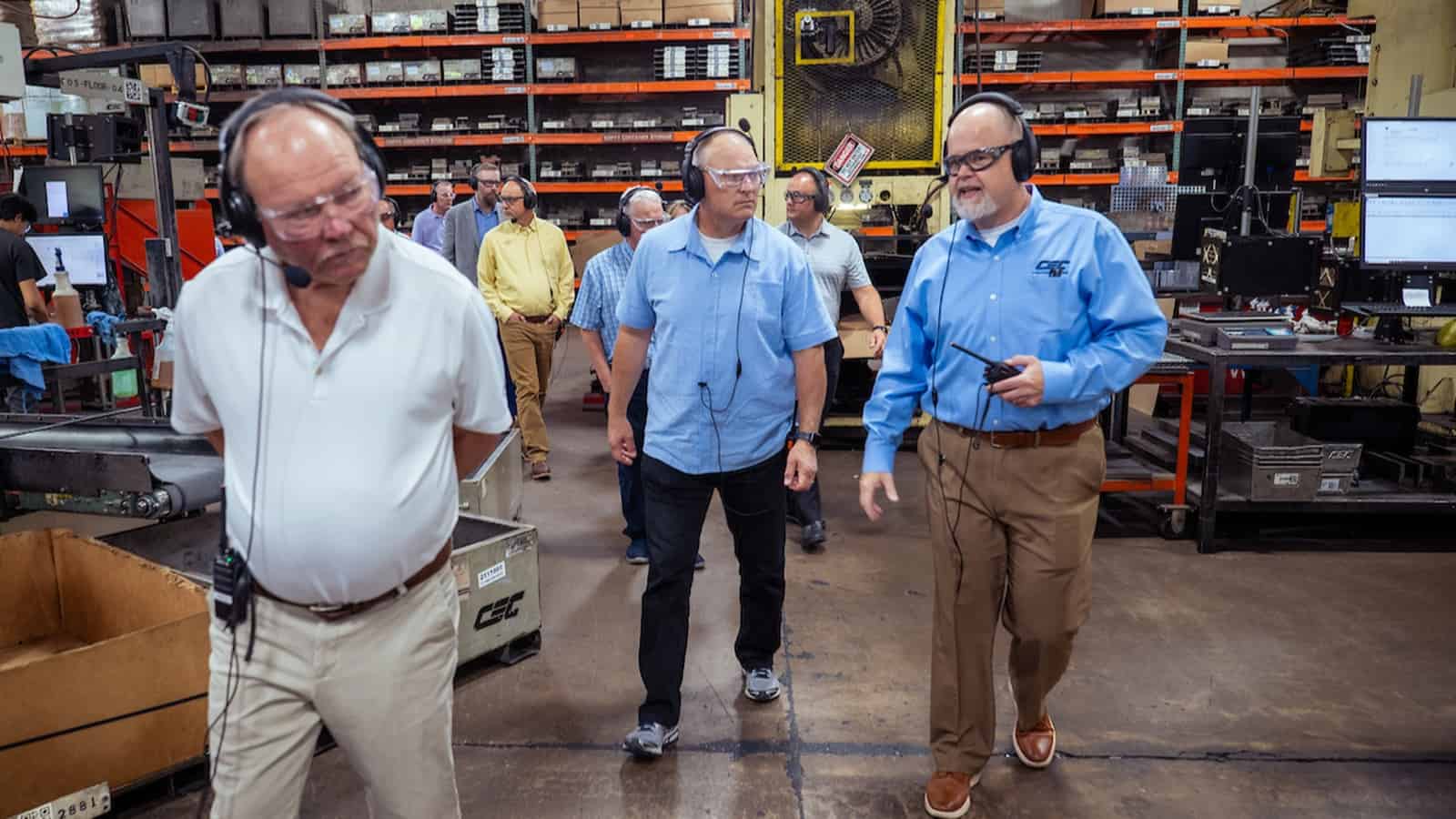
Permanent restoration of R&D expensing is a top priority for manufacturers in Minnesota and the U.S. in general. That’s why Rep. Pete Stauber (R-MN) plans to sign onto the American Innovation and R&D Competitiveness Act as a cosponsor, he recently told the NAM.
What’s going on: Rep. Stauber discussed the importance of competitive R&D tax policy, along with the regulatory onslaught targeting manufacturers and the need for permitting reform, during a recent NAM-organized facility tour of Clow Stamping Co. in Merrifield, Minnesota.
- “Full expensing for R&D costs in the year in which they are incurred is essential for innovation and competition,” Rep. Stauber told the group, which included Pequot Tool & Manufacturing CEO Karlo Goerges in addition to NAM representatives and Clow Stamping leadership. “It’s imperative that it be reinstated as soon as possible.”
- The American Innovation and R&D Competitiveness Act would restore immediate R&D expensing permanently for small businesses.
- “Full R&D expensing was instrumental in our growth until the law changed last year,” said Clow Stamping owner Reg Clow. “It’s definitely having an impact on us. Our expenses have gone way up.”
Workforce woes: Clow is nearing the end of a $20 million facility expansion that will add 107,000 square feet of floor space and at least 60 jobs—but finding enough workers to fill those jobs won’t be easy.
- By implementing automation in its shipping and receiving departments, the company will be able to both increase its shipping output without additional workers and channel its current hiring efforts toward filling open positions with the production departments, Clow said.
- This is a short-term solution, however, and manufacturers like Clow Stamping need policymakers’ help to ensure the industry has enough skilled workers for the decades to come.
- During the facility visit, the group discussed the importance of educating younger generations about the many opportunities available in manufacturing, via initiatives like Creators Wanted. This award-winning perception campaign undertaken by the NAM and its 501(c)3 workforce development and education affiliate, the Manufacturing Institute, aims to recruit 600,000 new manufacturing workers by 2025.
The last word: “Manufacturers account for more than 55% of all private-sector R&D spending in the United States,” said NAM Managing Vice President of Policy Chris Netram.
- “Policies that encourage this innovation will allow the industry to continue to drive our economy forward. The NAM thanks Rep. Stauber for his support of the American Innovation and R&D Competitiveness Act and calls on Congress to swiftly pass this bill.”
Creators Wanted and Union Pacific Dazzle the Twin Cities
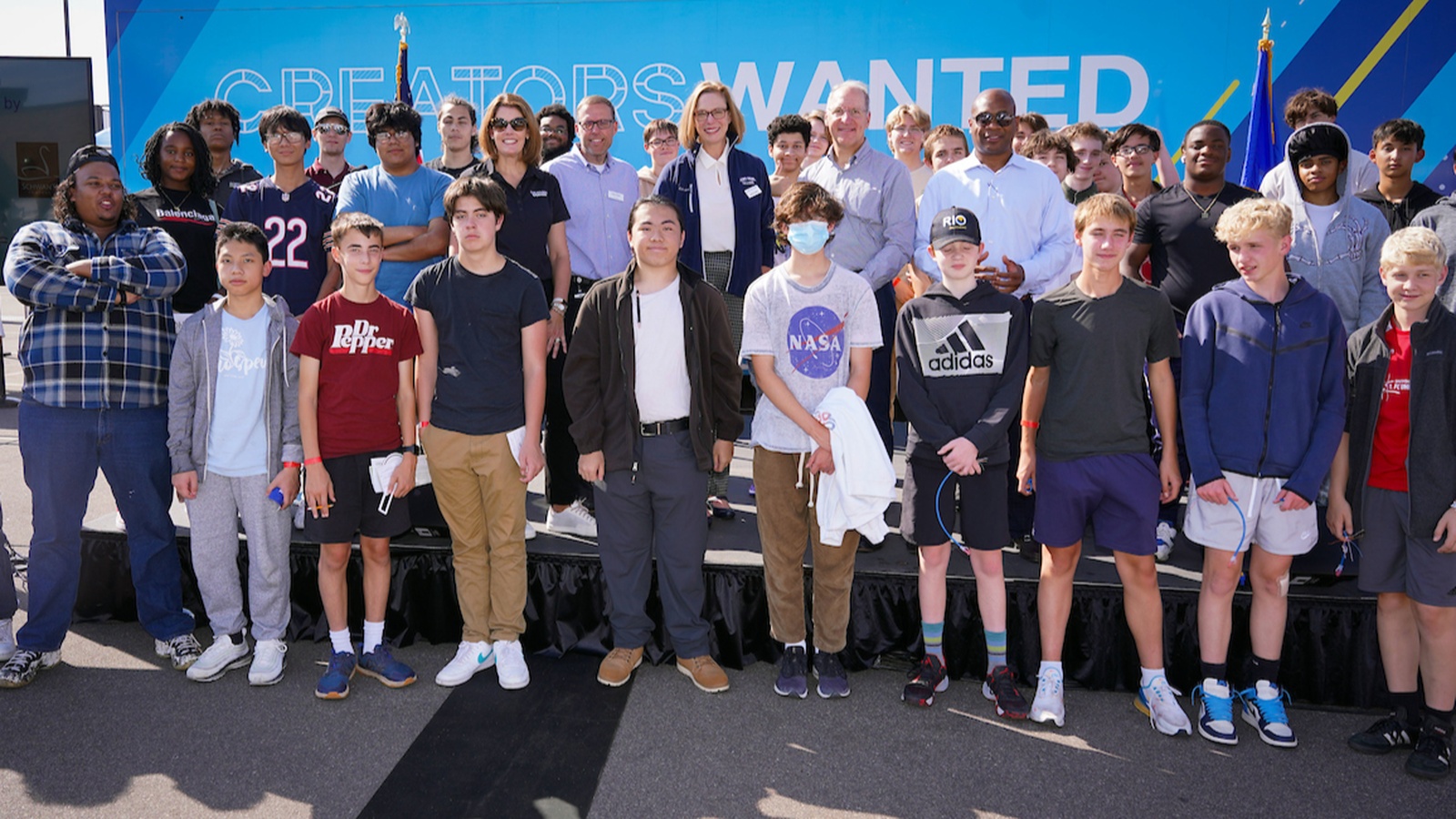
Last week, Saint Paul College in St. Paul, Minnesota, which boasts a student body that is 65% people of color, became the 19th stop of 20 for the Creators Wanted Tour, a joint project of the NAM and the Manufacturing Institute, the workforce development and education affiliate of the NAM.
Over three days, with Union Pacific as the lead sponsor, the stop drew more than 600 visitors, from students to educators. Meanwhile, 42,000 online signups in Minnesota helped the campaign surpass 1.5 million nationwide from students and career mentors interested in modern manufacturing careers.
Twin Cities kickoff: Union Pacific Executive Vice President of Marketing and Sales Kenny Rocker gave the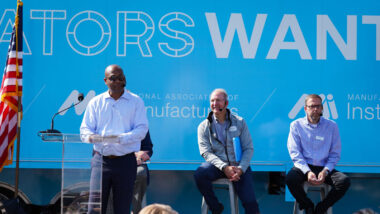 keynote address at the kickoff event, emphasizing the reward of manufacturing careers. He was joined by MI President and Executive Director Carolyn Lee, Saint Paul College President Dr. Dee Dee Peaslee, Minnesota Chamber of Commerce President and CEO Doug Loon and Trane Technologies Vice President of Product Management Dave Molin.
keynote address at the kickoff event, emphasizing the reward of manufacturing careers. He was joined by MI President and Executive Director Carolyn Lee, Saint Paul College President Dr. Dee Dee Peaslee, Minnesota Chamber of Commerce President and CEO Doug Loon and Trane Technologies Vice President of Product Management Dave Molin.
- “When I talk about opportunities, I’m talking about really good-paying jobs … At Union Pacific, we’re talking jobs that are … averaging over $100,000 a year, and that’s without benefits, and so you just really have an opportunity to make an impact from that perspective,” said Rocker.
- “At Trane Technologies, our vision is to boldly challenge what’s possible for a sustainable world,” added Molin. “It is the engine of our company, and we live it every day. And to do that, we need bright minds and the best minds in the world. We need diverse thinkers, we need creators, and our doors are open to everyone.”
- Notably, leaders from key government business and workforce partner organizations attended the kickoff, including the Minnesota State Advanced Manufacturing Center of Excellence, Minnesota Black Chamber of Commerce, Minnesota Parent Union and St. Paul Area Chamber, representatives from the offices of U.S. Reps. Brad Finstad (R-MN-1), Angie Craig (D-MN-2), Dean Phillips (D-MN-3), Betty McCollum (D-MN-4) and Michelle Fischbach (R-MN-7), Mayor of South St. Paul Jimmy Francis and State Reps. Jon Koznick (R), Emma Greenman (D) and Samantha Sencer-Mura (D).
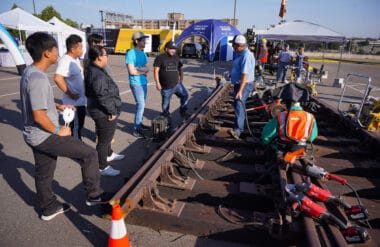
Experience and exploration: Students delved deep into immersive activities, from solving manufacturing-related puzzles in the Creators Wanted mobile experience to virtually navigating a locomotive through Union Pacific’s simulators. Equally captivating was the sight of the actual railroad track, which was complemented by insightful career anecdotes from Union Pacific professionals.
- Eighty-seven percent of students surveyed reported a significantly improved view of modern manufacturing careers after completing the immersive experience.
Live Q&A sessions: The stop also offered structured opportunities for students to learn about manufacturing organizations’ support for the next generation of talent, along with the importance of mentorship and personal development in shaping successful careers.
- The first session, featuring two Union Pacific senior managers—Amy Bang, Sr. manager of diversity and inclusion, and Ken Kuwamura, Jr., manager of talent acquisition—and Saint Paul College instructors, zeroed in on the crucial roles of mentorship, diversity and passion in career selection.
- The second session, with Jake Yernberg, automotive instructor, Saint Paul College; Caitlin Bundy, manager of corporate sustainability, Union Pacific; and Preeti Subramanian, senior product manager, Trane Technologies, accentuated the pivotal role of manufacturing in tackling global challenges. Panelists pointed out the advantages of the manufacturing sector, citing competitive pay and the sector’s potential in addressing global issues, such as sustainability and climate change.
Interactive Learning: Everfi®, Ecolab and Schwan’s joined Union Pacific in bringing in representatives to give students career advice—and offer activities to spark their curiosity.
- Everfi® showcased a new digital education program, “Future Creators,” co-developed with the MI and Union Pacific, to give middle and high school students a peek into STEM careers.
- Saint Paul College also took students on a tour of its robust Trades and Technical Education program.
Beyond the Tour: The Twin Cities event is a part of Union Pacific’s overarching “Careers on Track” initiative, which aims to inspire more women and youth to pursue modern industrial careers, and the Creators Wanted campaign’s sustained drive to enhance perceptions of manufacturing careers in the United States and empower more people to create the future.
The last word: “I want all of you out here, the students, to have an opportunity to go out there and win and compete and further your careers and do well in life,” said Rocker, echoing a theme the Creators Wanted Tour has promoted since its inception: manufacturers and manufacturing care about students and their future.
Next up: The pioneering Creators Wanted Tour concludes next month, Oct. 17–21, at the Circleville Pumpkin Show in Circleville, Ohio.
UAW Sets New Strike Deadline

The United Autoworkers union set a new strike deadline late last night, according to The Street.
What’s going on: In a video post on X, “UAW president Shawn Fain said [the union] would unveil more strike targets, with more union members participating, by noon eastern time Friday failing significant progress in talks with Ford, General Motors and Chrysler-owned Stellantis.”
- After negotiations for a new four-year labor contract failed late last Thursday, the UAW—which represents almost 150,000 U.S. autoworkers—ordered a walkout from vehicle plants belonging to the “Big Three” carmakers in Michigan, Missouri and Ohio.
- About 12,700 workers are now picketing assembly lines throughout the Midwest.
- Each of the vehicle manufacturers has put forth offers in recent days, and each has been rejected by the union, the demands of which include a sizable wage raise and a 32-hour workweek at 40-hour-a week pay.
Why it’s important: A 10-day strike of 143,000 UAW members against the three vehicle manufacturers could mean an economic loss of $5.617 billion, according to a recent report by Michigan-based consultancy Anderson Economic Group.
- A protracted strike this year would put “the state of Michigan and parts of the Midwest … into a recession,” Anderson Group CEO Patrick Anderson told the news outlet.
Our take: “ The economic harm produced by a strike goes well beyond GM, Ford and Stellantis,” said NAM Vice President of Domestic Policy Brandon Farris.
- “Numerous small and medium-size manufactures are already feeling the effects. The NAM encourages a swift resolution. Let’s get everyone back to work building products that our country relies on.”
Workers Stage Walkout at Detroit’s “Big Three”

The United Auto Workers union went on strike for the first time at all the Detroit “Big Three” carmakers early this morning, according to The Wall Street Journal (subscription).
What’s going on: “UAW officials initiated the walkout after failing to clinch new labor deals with General Motors, Ford Motor and Jeep-maker Stellantis for about 146,000 U.S. factory workers. Bargaining went late into the night, but the two sides remained too far apart to avoid a walkout at the 11:59 p.m. ET deadline.”
- Workers at a Ford Bronco plant in Detroit, a GM pickup-truck factory in Missouri and a Stellantis Jeep plant in Ohio were told to leave their posts.
- The three targeted facilities make some of the firms’ most popular vehicles.
Why it’s important: Automotive manufacturing in the U.S. is among the most productive industries in the world, underpinning the American economy as a whole.
- In fact, a strike of 143,000 UAW members against GM, Ford and Stellantis could lead to an economic loss of $5.617 billion after just 10 full days, according to a recent report by Anderson Economic Group.
- In 2019, a 42-day strike at one of the three vehicle manufacturers put the state of Michigan into a quarter-long recession and resulted in an economic loss of $4.2 billion, according to The Detroit News.
Our response: “The impact of this strike will echo far beyond the city of Detroit, as multiple economic analyses have demonstrated,” NAM President and CEO Jay Timmons said this morning. “The small and medium-sized manufacturers across the country that make up the automotive sector’s integrated supply chain will feel the brunt of this work stoppage, whether they are a union shop or not.”
- “American families are already feeling economic pressures from near-record-high inflation, and this will only inflict more pain. We urge a swift resolution to end this strike and avoid further undermining the strength of our industry and harming our broader economy.”
NAM in the news: Bloomberg (subscription), POLITICO, Reuters (subscription) and Bloomberg Law (subscription) all covered the NAM’s response to the walkout.
How Manufacturers Can Tap into a Large, Talented Workforce
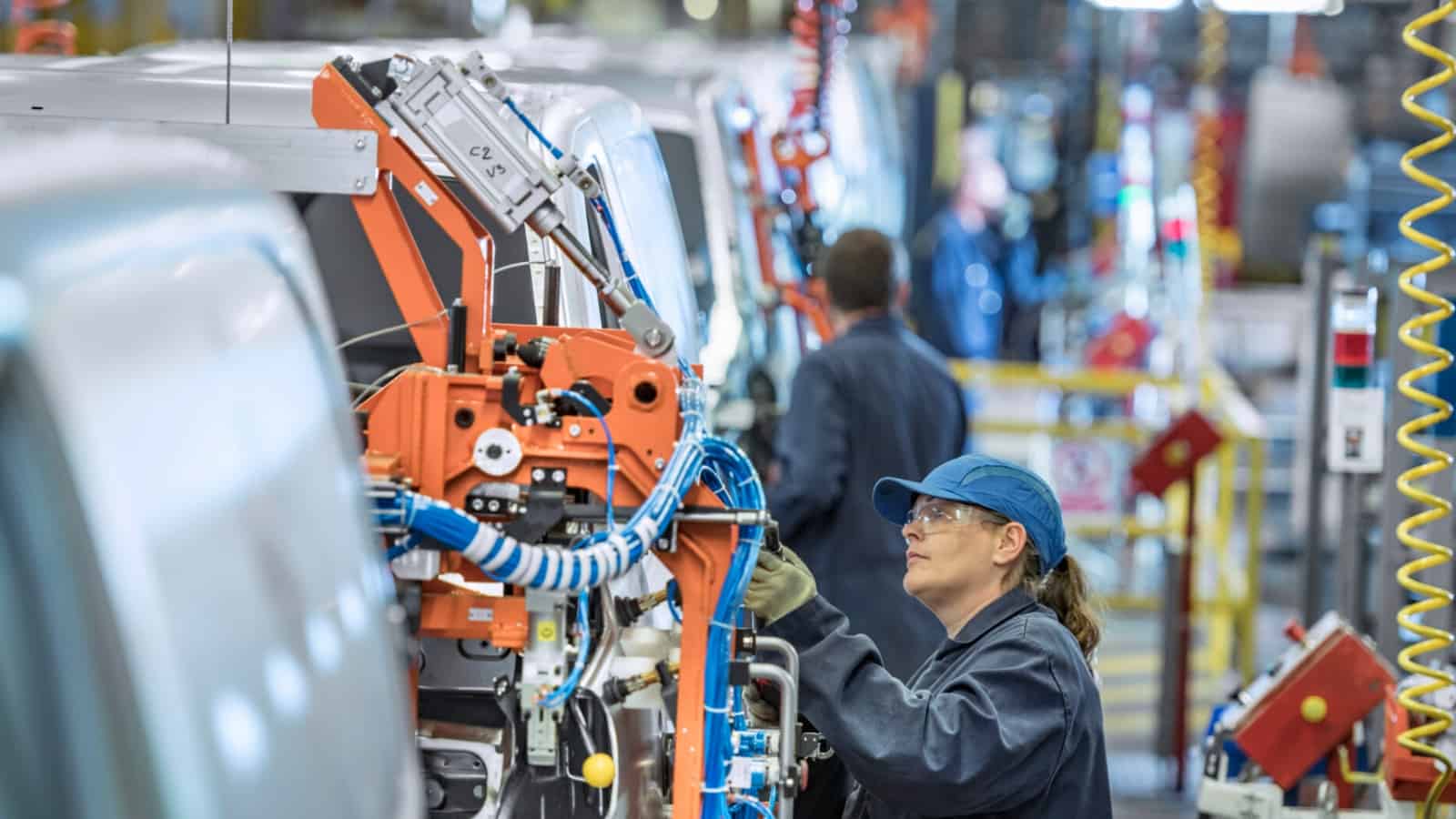
Discipline, reliability, a team-player mindset, leadership—manufacturers are looking for all these qualities in the talent they recruit. What if companies could tap into a population not only equipped with these skills but experienced in using them in high-stakes situations?
Well, the Manufacturing Institute—the workforce development and education affiliate of the NAM—has good news, if you haven’t heard it already: this population exists, and it’s military talent. Transitioning service members, veterans, National Guard members, reservists and military spouses have a wealth of skills and experience that translate easily into a manufacturing context.
So how can manufacturers reach these workers and make the best use of them? The MI recently convened both military and manufacturing leaders in Fayetteville, North Carolina, for its third Workforce Solution Series event, where they answered this question and offered a range of useful advice. Here are some of the highlights.
Generally speaking: Major General Eugene J. LeBoeuf, Deputy Commanding General, U.S. Army Reserve Command, highlighted the talents and skillsets that Army reservists can offer the manufacturing industry, including agility, a can-do attitude and a thorough grounding in engineering, logistics and mechatronics.
- With nearly 190,000 soldiers, the Army Reserve comprises much of the readiness force of the U.S. Army. Many of these reservists are underemployed or unemployed, which means they represent an opportunity for manufacturers.
- Manufacturers interested in hiring from this labor pool can partner with the Private Public Partnership Office, which connects companies with reservists at no cost.
Reaching military talent: Several panelists emphasized the importance of developing recruitment processes that encourage military talent to apply and interview for manufacturing jobs.
- “Make sure that the requirements you’re listing in your position descriptions are actually required. Do you really need someone to have a master’s degree to get the job done?” asked Rob Patton, vice president of Fayetteville Cumberland Economic Development Corporation.
- As a recently transitioned service member, James Goppert, HR business partner at WestRock, explained some of the challenges that military talent may face when entering the workforce. “Having to explain military skills and certifications to a civilian in an interview was strange. It would have been helpful to have someone on the other side who understood my experiences.”
Open to all possibilities: Jennifer Goodman, senior manager of talent initiatives at Coca-Cola Consolidated, drew on her experiences as a military spouse. “Military spouses are 92% women and have a 22% unemployment rate. That’s a huge labor pool that’s going underemployed or unemployed.”
- While relocation is often a concern for companies, Goodman points out that it does not have to be a disadvantage. “Think of manufacturers who have locations across the country. Maybe you can start a military spouse at one location and then move them to another. Or, if they’ve proven themselves after a few years, you could transition them to remote work.”
- “The benefits don’t stop with the one military spouse you hire,” she added. “We’re a very loyal community with great word of mouth and a larger referral network.”
The last word: “Don’t underestimate the value of an event like this Solution Series can have. You can take the information, energy and passion that you get from meeting with people who have the same goal of building a stronger economy and use it to power you forward,” said Nathan Huret, economic development director for Catawba County.
Learn more: To get started—or continue—with hiring military talent, check out the extensive resources of the MI’s Heroes MAKE America initiative, which prepares prospective military workers for new and rewarding careers in manufacturing.
IMF Raises Global Growth Forecast

The International Monetary Fund raised its growth forecast for the international economy on Tuesday despite slowing activity in China, according to CNBC.
What’s going on: “In the latest update to its World Economic Outlook, the IMF raised its 2023 global growth prediction by 0.2 percentage points to 3%, up from 2.8% at its April assessment. The IMF kept [its] 2024 growth forecast unchanged at 3%.”
- The IMF expects inflation to improve, too, and sees core inflation “declining more slowly to 6% this year, from 6.5% last year.”
- IMF Chief Economist Pierre-Olivier Gourinchas wrote in a blog post Tuesday that “the signs of progress are undeniable.”
However … Global economic challenges remain on the horizon, the IMF cautioned, citing a less-than-robust Chinese economic recovery from the pandemic, weakness in China’s real-estate market and an expected contraction of Germany’s economy.
- In Germany, manufacturing output declined in Q1 2023.
- Across nations that use the euro, “[d]ata released Monday showed business activity shrinking at a faster pace than expected.”
Our take: “While there continue to be significant challenges in the manufacturing sector globally, it is encouraging to see signs of resilience—not just in the U.S. economy, but in other markets as well,” said NAM Chief Economist Chad Moutray.
Workforce Retention Begins with Culture at Ketchie

For Ketchie President and Owner Courtney Silver, retention all starts with culture. “I’m really happy to be here” is a phrase she hears often on her shop floor—and it tells her that the work culture at her company is in good shape.
- “A culture of empowerment that’s built on trust really fuels our team I think,” said Silver, who is the chair of the NAM’s Small and Medium Manufacturers Group. “They find so much dignity and purpose in fulfilling our mission here at Ketchie.”
Maintaining a high-performing, motivated and engaged workforce is a top priority for the third-generation precision machine shop in Concord, North Carolina, and Silver has implemented a number of strategies to keep it that way.
Team recognition: Every Wednesday, during Ketchie’s shift meeting, employees have the opportunity to recognize their team members for any achievement, big or small.
- “Recognition can be about anything,” says Silver. “It can be ‘Fred over there was able to cut five minutes of cycle time off this particular part because he changed the process’ or ‘Mary saved us money by switching out some tooling.’ We then post the feedback in the break room and email it out to the entire organization.”
- “There are so many things that can go wrong in manufacturing just trying to get a part out the door, and this is an opportunity to think about all the amazing things we’re doing,” she explained.
Silver also posts worker productivity charts every week. If workers meet their productivity goals and their indirect time goals, they get performance points, which are redeemable for gift cards.
- “I think people want to know if they’re on a winning team,” Silver said. “If you’re winning, it feels good. We’re all on the bus going in the same direction.”
Motivator Award: Each year, employees can also nominate a peer for the “Motivator Award,” which goes to the employee who best exemplifies Ketchie’s core values: to do the right thing, be agile and embrace continuous improvement.
- To honor the winner, Silver puts together a tribute video of team members sharing their thoughts about the employee and hosts a company brunch in celebration (to which the employee’s family is invited).
- “The winner also receives their own special parking spot, an extra day of vacation and a $1,000 gift certificate to the Marriott to take vacation with their family,” says Silver.
- “The team member that won the award last year had tears in his eyes, so I know that it’s been really impactful,” she continued.
Community service: Ketchie’s employees are passionate about giving back to the community. Through service projects, Ketchie supports the Boys & Girls Clubs of America as well as Cooperative Christian Ministry, which offers programs that relieve hunger and food insecurity and address homelessness and housing costs.
Opportunity Knocks: Silver isn’t only working to retain and support current employees, but also to train and mold the young people who will be tomorrow’s machinists.
- This year, Silver started an internship program for high school students named Opportunity Knocks. It allows students to shadow experienced machinists in factory environments while earning school credit.
- The interns go through a curriculum created by Edgerton Gear, Inc., called Craftsman with Character, a 16-week course that helps students explore the role of character in a professional trades environment. Silver said the course, which includes leadership and manufacturing-focused exercises, is taught at Ketchie four days a week in two-hour sessions. Three days of the week are job shadowing machinists on the shop floor, and one day is in a classroom setting at the shop discussing character traits and soft skills. The conversations lean on discovering what’s important in life and what might make them happy.
- “They absolutely love these high schoolers,” said Silver about the two mentors at Ketchie, who each have more than 30 years’ experience. “It gives them an opportunity to share their entire work career: what they’re doing, experiences learned along the way. It’s been neat to see.”
Investing in technology: Silver knows her team wants to work for a company that’s growing and investing in technology. She recently purchased a machine-tending collaborative robot, which takes over machinists’ “least favorite” part of the job—changing parts while the machines run.
- “I interviewed somebody recently who said to me in the interview, ‘It’s really good to see that you want to grow and that you’re making these big investments,’” said Silver. “You’re buying new technology that excites them. They want to be part of that mission and growth.”
The last word: Silver shared some advice for companies that might be struggling with workforce retention.
- “Use employee surveys, focus groups or roundtable discussions to see what you need to do or should do. Everyone wants to be heard. It’s important to listen.”
The NAM’s workforce development and education affiliate, the Manufacturing Institute, has many initiatives to help employers retain and develop their teams. For a deeper dive, check out this study by the MI on improving retention and employee engagement. The MI will also explore retention challenges and solutions at its Workforce Summit in Atlanta on Oct. 16–18. Click here for more information.
Labor Market by the Numbers – July 2023
The big number: 74.4% of respondents in the Q2 NAM Manufacturers’ Outlook Survey cited the inability to attract and retain workers as their primary business concern, even amid signs of a cooling labor market. This is the third consecutive quarter in which this concern appeared at the top of respondents’ list.
- In the previous survey, more than 59% of manufacturers said that not having enough employees would impact their ability to make investments or expand.
Manufacturing: Manufacturing employment rose by 7,000 in June, continuing to seesaw from month to month over the year to date.
- The sector added just 15,000 workers during the first six months of 2023, slowing materially after adding a robust 385,000 and 390,000 employees in 2021 and 2022, respectively.
- More positively, there were 12,989,000 manufacturing employees in June, just shy of February’s total of 12,988,000, which was the most since November 2008.
Nonfarm payrolls: Nonfarm payroll employment rose by 209,000 in June, slowing from 306,000 in April but still a good figure. The U.S. economy has added 1,669,000 workers through the first half of 2023, a robust pace.
- The unemployment rate edged down from 3.7% in May to 3.6% in June, as the economy remains at or near “full employment.”
- The number of employed workers increased from 160,721,000 in May to 160,994,000 in June, which was not far from April’s record level (161,031,000). Those who were unemployed declined from 6,097,000 to 5,957,000.
- The labor force participation rate remained at 62.6% for the fourth straight month, the best rate since March 2020.
Job openings: There were 604,000 manufacturing job openings in May, down from 668,000 in April and the lowest level since February 2021. Even with the overall labor market remaining solid, the number of job postings in the sector continues to cool notably, as expected.
- Total quits in the manufacturing sector rose to 293,000 in May, an 11-month high. In addition, total quits in the overall economy increased to 4.015,000, the most since December.
- With that said, layoffs in the manufacturing sector have also risen, up to 139,000 in May, the highest level since July 2020.
- Meanwhile, nonfarm business job openings declined from 10,320,000 in April to 9,824,000 in May, a solid reading. In May, there were 62.1 unemployed workers for every 100 job openings in the U.S. economy.
Wages: The average hourly earnings of production and nonsupervisory workers in manufacturing jumped 1.0% to $26.41 in June, with 5.6% growth over the past 12 months, up from 4.7% in May.
➔ Key takeaway: Manufacturers continue to cite an inability to attract and retain workers as their top challenge. While there are signs that the labor market is cooling, both for manufacturers and the macroeconomy, employment remains not far from a 15-year high while wage growth continues to increase very solidly.
Solutions Center: Flexibility Working Group – July 2023
Lack of flexibility is a top workforce challenge for employees, according to a recent report released by the MI. To address this concern and help employees attract and retain more workers, the MI has been convening manufacturing leaders to discuss flexibility solutions, identify what’s working and share insights. Here are some of the key takeaways.
The shop floor challenge: Flexible work arrangements for shop floor workers are different from those offered to office staff or remote workers, as manufacturers must fulfill in-person production requirements and timelines.
- Companies have gotten creative, testing out different options including compressed work weeks, rotating schedules, flex scheduling, shift swapping and phased retirements.
A data-driven approach: Participants in the MI’s working group conducted surveys to gauge the types of flexibility their employees wanted. Companies then assessed production needs before determining what flexibility options they would test, sometimes with the help of a consultant.
- One company collected data on recruitment and retention as part of their pilot to help evaluate its effectiveness.
- Other companies utilized employee engagement surveys to assess the success of their pilots.
Support system: Companies in the working group talked about the importance of creating support structures for flexibility plans.
- For example, one company hired a training and scheduling coordinator to manage their new systems. Others employed technology platforms to organize shifts.
- Supervisors also needed to be trained to handle new systems and manage flexibility requests while meeting production demands, the participants noted.
Stay tuned: The MI is planning to release a white paper based on the working group discussions in the fall.